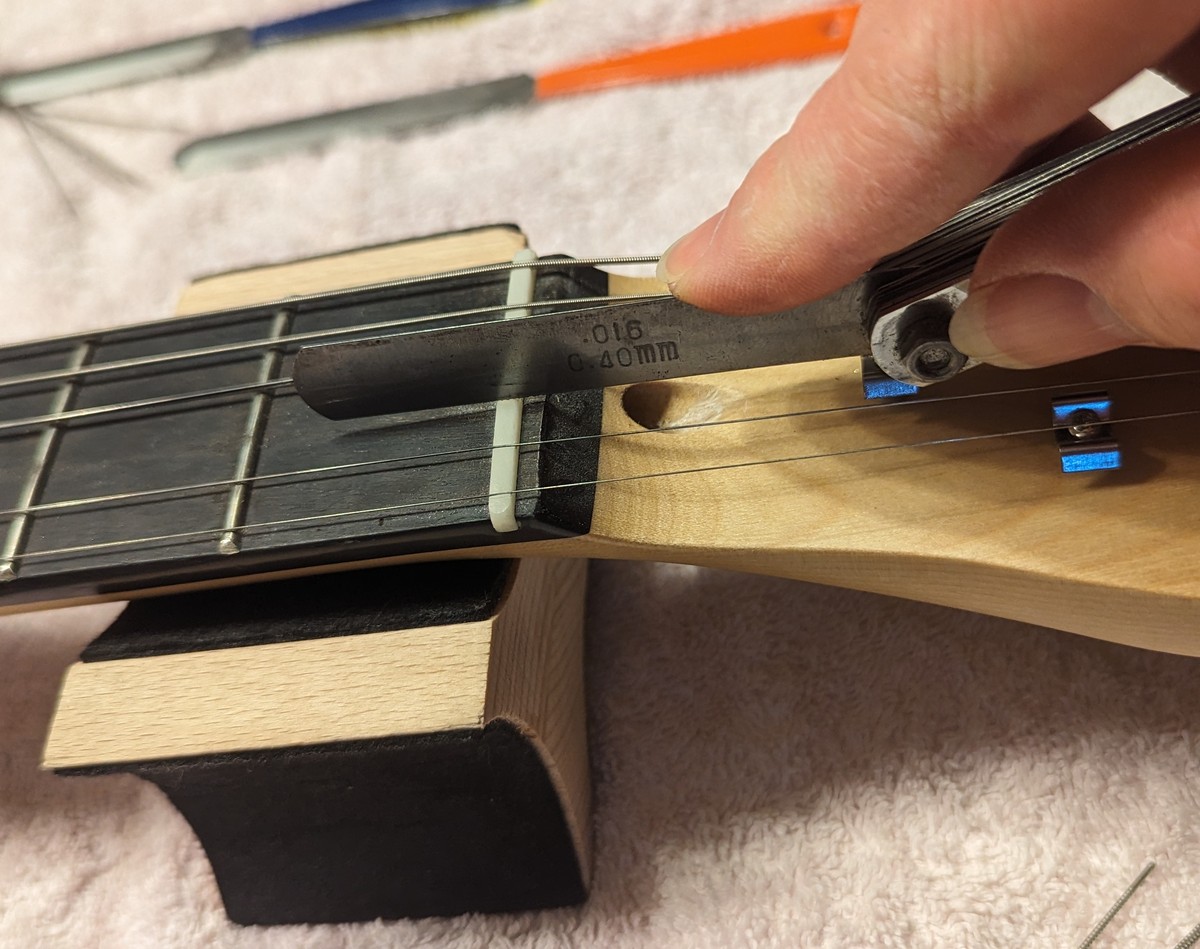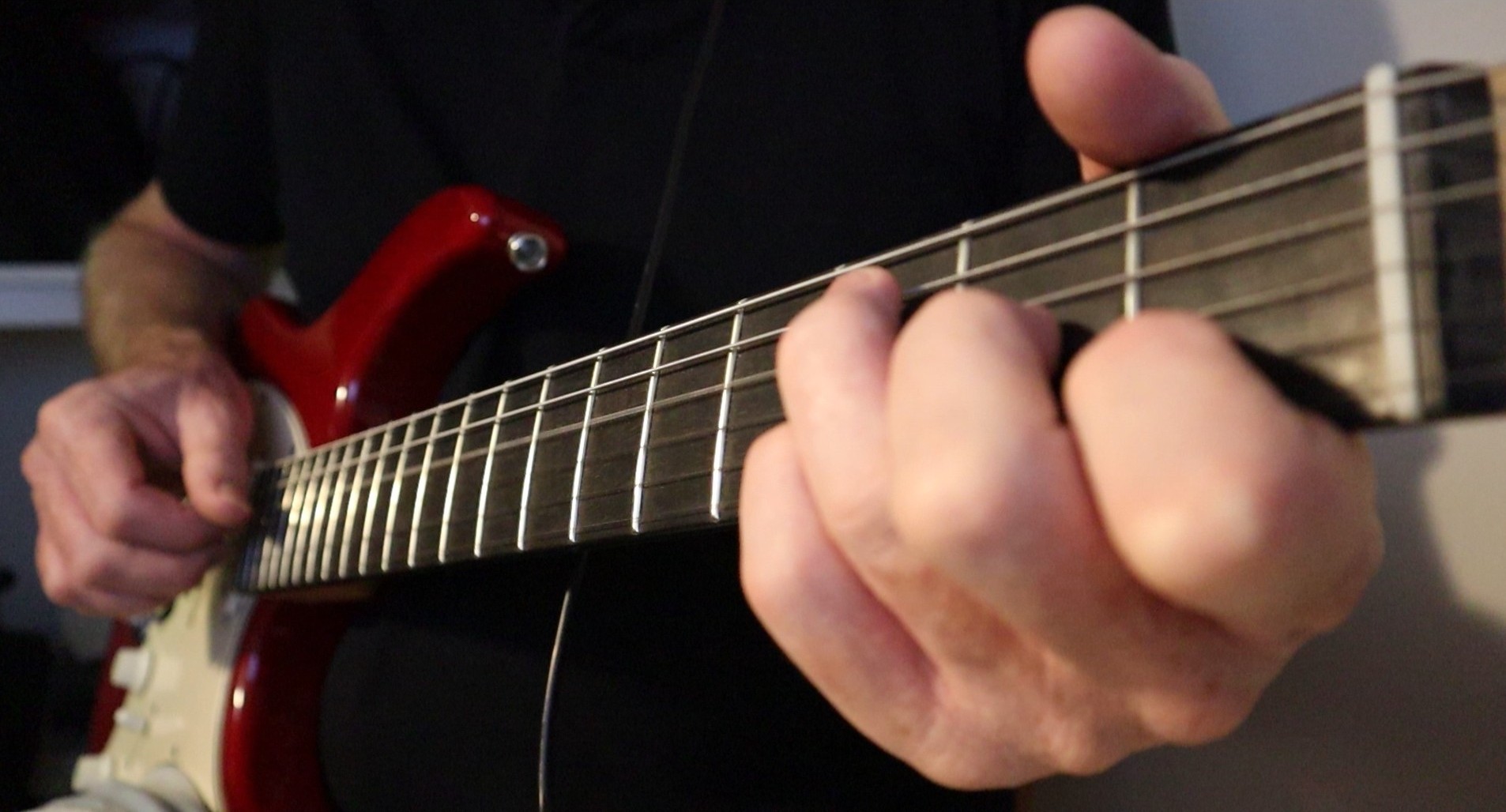A while ago I decided I needed an electric guitar. I bought an interesting one that had a UST pickup in it. I remembered pretty quickly afterplaying it for a while that electric guitar necks are too narrow - generally a nut width of about 43mm. I next had a company in China build me a custom neck - 48mm wide - but I accidentally specified Stat style heel rather than the Tele style heel that guitar actually needed so it wouldn't fit on the guitar. Not dismayed, I picked up a cheap Stat copy from my local pawn shop and fitted the neck. It was okay, but I hadn't made a good nut for it, so the intonation was bad.
Nonetheless I started using it as my practice/arrangement guitar, mostly because it is quiet and yet the neck feels like a classical neck, and the string tension is not that far off a nylon string. I've been playing it more than my actual classical... a lot more.
I thought to myself "why don't I fix up the nut so it intonates better, and do some of my normal recordings with it?" Because to set up a recording with microphones with the classical requires a bit of effort and the house to be quiet. My house is rarely quiet.
Getting the nut better is becoming an easier process for me, I have made a few saddles and nuts now. I have a feel for what you need to do, and am getting a bit quicker at it. This one was easy, the strings all just needed to be closer to the fretboard.
I remembered why I stopped adjusting it last time - you have to be able to file a very narrow groove - the width of a string - into bone. I had tried the welder nozzle cleaner files and they are okay, but not with the really fine files, it's not really possible.
I remembered a trick I had seen on the internet - modify a set of feeler gauges. The idea being that feeler gauges come in all the exact widths you'd need, and they are kinda tall so they don't flop around like a 0.4mm round file. So I grabbed my feeler gauge, measured up each string with a caliper, got the corresponding feeler gauge out, and roughed up a section with a heavy duty file. I didn't need to make it super rough, or even a very long section. I did clean up the burs on the sides by running the edges flat over some sandpaper, and rounded it ever so slightly so it wouldn't cut a completely square slot.
The end result is great. You don't need to file much, it is only slightly abrasive which is fine for a thin bone slot and you aren't going deep anyway.
I quickly had the nut slots the perfect width per string deep enough that you only had to press the string down a tiny bit before it was touching the fret. How far? Well, I figure if you fret at the first fret, and then look at how close the string is to the second fret, you want about that same distance. Leave a bit extra - nuts wear down during tuning, so have a bit of meat there so it lasts longer than the first string change.
Once I re-tuned and then fretted at the first fret the intonation was not perfect but a lot better. I still fret like an acoustic player - mashing those strings down so of course I am going to go a bit sharp anyhow - I need to develop a lighter touch for electric guitars. But I was happy enough.
The next stumbling block recording on an electric, is how to play with headphones on through whatever effects pedal you want to hear, possibly listening to a click at the same time, all while recording just the guitar.
This should not be a stumbling block of course, people have been recording through interfaces for years. I had bought a nice little Behringer mixing desk with USB output for a cheaper price than an interface, and that has come in super handy as both a mixer and for recording. Because whatever you mix can be sent straight to a computer as a 44.1kHz 16 bit USB stereo signal.
The problem now is latency. If you are sending your mix to a giant amp that you are listening to, and recording in the background, then latency is not a problem, it can be seconds, who cares! But if you pluck a string and are listening in headphones from the computer then there should be no delay (no latency). I reckon I can hear latency starting at around 10-15ms.
Out of the box the average computer hardware running Microsoft Windows will not achieve 10-15ms. The standard Microsoft audio driver is "DirectSound", and it is not made for real-time audio. You will be quite sad if you try to use it for real-time audio.
However if you switch to ASIO as your audio driver, you should be able to get your 10-15ms. Unless you have a specific ASIO driver for your USB interface, download and install "ASIO4ALL". From Reaper/Audacity/etc go to your audio setup, choose ASIO, and click on the ASIO Configuration. Things to try: test out Hardware Buffer, I found setting this with anything around 12ms-20ms worked great. Try setting the block size to 64. Keep the sample frequency at 44.1kHz/16 bit.
If you hear latency, then decrease the values. If you hear noise - like the occasional pop and click, then increase the values. I was able to find a noise free setting that had a latency that I could tolerate.
With that all done, I found with ASIO I couldn't play a click track or anything else at the same time! That is because ASIO will only run exclusively, it won't share with other audio. I found if I went back to DirectSound and recorded a click track, and then back into ASIO mode I could play the click track and overdub, so it's okay.
Otherwise, try out WASAPI. This is the Microsoft equivalent to ASIO. It's pretty good, it will run in shared mode so it is almost the same as using the default DirectSound in that respect. It has similar settings to ASIO, play around with the buffer size, and set the thread priority to Time Critical.
I found I couldn't quite get as good latency out of WASAPI as I could from ASIO. This is all on an 8 year old Dell laptop running Windows 10, so hopefully you have more joy!
So once I was ready with a guitar that would play in tune, with a recorder that could record noise and delay free while I was listening, I hit the next road block.
Well, two road blocks.
I couldn't get the tone I wanted, and my fingerpicking doesn't translate well to coil pickups. Huh?
Tone - I am using my Zoom G Four multi-effects pedal, so I can dial in any patches I want. I found an acoustic simulator with a tiny bit of reverb, running through the neck pickup only at about 50% tone was barely okay - I could live with that - but it just isn't the sound of a classical guitar.
Fingerpicking with a consistent dynamic and tone is hard on electric! I only had to pick ever so slightly different between notes, almost imperceivable, and that different dynamic leaps out. Only have to flick the strings percussively a tiny bit different to the previous and it is the difference between a kick drum and a closed high hat!
I dialed in some compression and this squeezed those inconsistent dynamics together and made them less obvious... but you know what? It squeezed the dynamics together! I _want_ the actual dynamics that I want when I'm playing!
So my years of nylon string has meant I don't have the ultra-fine control of my dynamics I need for an electric guitar.
I haven't given up, but for now, I think I will stick to practice on the electric but recording on the nylon. (Oh, and all this practice on the electric is making me rusty on nylon...)


No comments:
Post a Comment